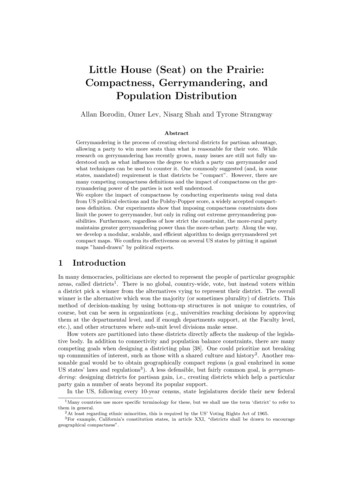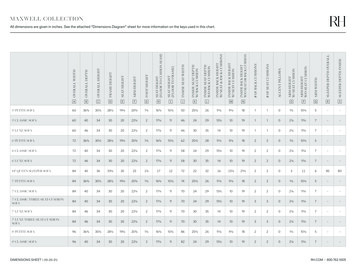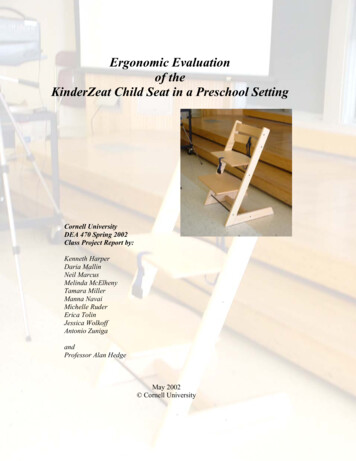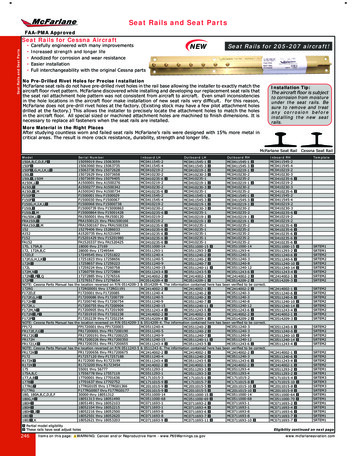
Transcription
Little House (Seat) on the Prairie:Compactness, Gerrymandering, andPopulation DistributionAllan Borodin, Omer Lev, Nisarg Shah and Tyrone StrangwayAbstractGerrymandering is the process of creating electoral districts for partisan advantage,allowing a party to win more seats than what is reasonable for their vote. Whileresearch on gerrymandering has recently grown, many issues are still not fully understood such as what influences the degree to which a party can gerrymander andwhat techniques can be used to counter it. One commonly suggested (and, in somestates, mandated) requirement is that districts be ”compact”. However, there aremany competing compactness definitions and the impact of compactness on the gerrymandering power of the parties is not well understood.We explore the impact of compactness by conducting experiments using real datafrom US political elections and the Polsby-Popper score, a widely accepted compactness definition. Our experiments show that imposing compactness constraints doeslimit the power to gerrymander, but only in ruling out extreme gerrymandering possibilities. Furthermore, regardless of how strict the constraint, the more-rural partymaintains greater gerrymandering power than the more-urban party. Along the way,we develop a modular, scalable, and efficient algorithm to design gerrymandered yetcompact maps. We confirm its effectiveness on several US states by pitting it againstmaps ”hand-drawn” by political experts.1IntroductionIn many democracies, politicians are elected to represent the people of particular geographicareas, called districts1 . There is no global, country-wide, vote, but instead voters withina district pick a winner from the alternatives vying to represent their district. The overallwinner is the alternative which won the majority (or sometimes plurality) of districts. Thismethod of decision-making by using bottom-up structures is not unique to countries, ofcourse, but can be seen in organizations (e.g., universities reaching decisions by approvingthem at the departmental level, and if enough departments support, at the Faculty level,etc.), and other structures where sub-unit level divisions make sense.How voters are partitioned into these districts directly affects the makeup of the legislative body. In addition to connectivity and population balance constraints, there are manycompeting goals when designing a districting plan [38]. One could prioritize not breakingup communities of interest, such as those with a shared culture and history2 . Another reasonable goal would be to obtain geographically compact regions (a goal enshrined in someUS states’ laws and regulations3 ). A less defensible, but fairly common goal, is gerrymandering: designing districts for partisan gain, i.e., creating districts which help a particularparty gain a number of seats beyond its popular support.In the US, following every 10-year census, state legislatures decide their new federal1 Many countries use more specific terminology for these, but we shall use the term ‘district’ to refer tothem in general.2 At least regarding ethnic minorities, this is required by the US’ Voting Rights Act of 1965.3 For example, California’s constitution states, in article XXI, “districts shall be drawn to encouragegeographical compactness”.
congressional borders, and partisan concerns are often part of the consideration [37]. Forexample, in the 2020 federal election in North Carolina, a state accused of gerrymandering(partially overturned by courts [9]), the Democratic party received 49.96% of the vote andwon five districts; the Republican party received 49.41% of the vote and won eight districts.As noted above, due to the many competing goals, even with clearly stated goals it is notclear what is fair or optimal when it comes to non-partisan districting (see Wasserman [38]for further discussion and a comparison of objectives).Parallel to the political partisan redistricting process there is a more complex, ongoingpopulation-wide process. In the US [3, 29] and Europe [26], voters are reorganizing themselves, living closer to other voters with similar political viewpoints. Voters of left leaningparties are clustering in urban centres; while voters of right leaning parties tend to spreadout in rural regions.Our work explores aspects of both of these processes – both the immediate partisan one,as well as the process of population sorting. In the first part of our work (Section 5), weintroduce our automated redistricting procedure, which, unlike some previous work, operateson the scale of real-world data. Our method is flexible and can be used to design plans forvarious objectives, both partisan and nonpartisan. Compared to districts drawn by politicalexperts, we almost always match, and even sometimes exceed, their performance.Our algorithm allows us to examine possible requirements that have been suggested asa means to mitigate or eliminate gerrymandering. In particular, we study the impact ofa compactness requirement. In Section 6, a few compactness measures are considered andwe see that in the US, the more rural party (Republicans) still consistently outperformsthe more urban party (Democrats). Moreover, we see that this advantage is robust evenin a non-gerrymandered, optimally-compact plan. This advantage is necessarily not due topolitical gaming of the division process, but rather due to to the geographic spread of eachparty’s supporters.We further examine, in Section 7, how much compactness constraints affect gerrymandering possibilities. We see that, indeed, demanding stringent compactness constraints reducesthe ability of parties to gerrymander. However, in most cases, the compactness requirementallows for greater rural-party gerrymandering, as it can achieve more districts than its voteproportion would seem to justify.2Related WorkPolitical districting, and in particular gerrymandering, has long been studied within variousfields. There have been legal discussions [31, 19, 16], though recently the US Supreme Courtruled [30] that partisan gerrymandering cannot be addressed by federal courts. Gerrymandering has long been studied from a historical perspective [12, 6] and by political scientists[13, 17, 34, 14].Automated redistricting for various objectives has been widely studied in the computerscience and mathematics literature, since Vickrey [36] suggested its possibility (see Beckerand Solomon [2] for a recent summary). Various methods and suggestions for detectinggerrymandering can be found in Wang [37], Grofman and King [18], Puppe and Tasnádi[28], Fifield et al. [15]. A novel approach to district division, accepting gerrymandering asa given, was recently suggested [27], involving an iterated setting inspired by the “cut andchoose” algorithm for cake cutting. In any case, finding an optimal gerrymandered solutionhas been shown to be NP-hard in multiple variations [22, 11, 35].The AI community has been exploring dividing voters into groups [1, 5, 20], and moreconcretely geographic concerns, as in cake-cutting [32]. More specifically, with respect toour work, the AI community has explored gerrymandering and its connection to voter distri-
bution. Cohen-Zemach et al. [7] examined gerrymandering in a synthetic arbitrary graph,and Lewenberg et al. [22] examined gerrymandering when different parties have supportin different urban centres, finding greedy algorithms work decently well on their simulateddata. In their work each party has different urban strengths, unlike our work (and manyreal-world voting patterns), where there are distinct urban and rural parties. Both papers’methods ignored (or stretched) population bounds, creating districts that would be highlyillegal in any real districting plan. Finally, Borodin et al. [4] directly examine gerrymandering in urban/rural settings. They worked on small, structured simulations (16 16 grids),using an integer-linear programming based approach and respecting population bounds.While they found a rural party advantage, their method is unable to scale beyond small andstructured examples. Our technique respects population bounds on arbitrary planar graphswith tens of thousands of nodes.3ModelWe examine gerrymandering with a graph-theoretic formulation. We shall be using a USoriented terminology (states, precincts, etc.), but it holds true for any district geographicsetting. A state is an undirected graph G(V, E). Each node v V represents a precinct,a small geographic region where votes are aggregated4 . An edge (u, v) E represents thephysical adjacency of precincts u and v. For v V let nv be the number of people who livev who vote for party p in election e. Wein v, and np,ev be the number of people who live inPwill omit e when the context is obvious. Let N v V nv be the total number of voters inthe state. We limit our focus to two parties: the rural party (in the US, Republicans (R)),and the urban party (in the US, Democrats (D)).To create a districting plan we partition G into K vertex-disjoint subgraphs G1 , · · · , GK(the districts). The number of districts is externally determined (in the US, by a censusevery 10 years). There are two widely accepted requirements for legal districts in the USand elsewhere:Contiguity For each k [K], Gk must form a connected subgraph of G.Population balance-δ For each k [K],P1 δ v V (Gk )N/Knv 1 δ.The exact value of δ required in the U.S. changes between states (and judicial decisions).Informally, the criteria is that districts should be as near equal-sized in population as possible [21]. We take δ 0.005, so that any two districts are, at most, within 1% of each other.This is the legal requirements in some states (and far tighter than many previous works ongerrymandering).PPAs an example, for an election e and district k, if v V (Gk ) nD,2012 v V (Gk ) nR,2012vvwe say the Democrats won the district according to the 2012 presidential vote totals. If theinequality is reversed we say the Republicans win district Vk in that election. Ties are brokenarbitrarily, though they have not occurred in our dataset. Note that this definition is onlyone possibility to define winning. In Section 5.1 we will look at winning as a probabilisticevent, blending vote totals from prior elections.4 In the US, census block data is more fine grained, but it does not contain any voting information, sonot useful for our needs.
4Election SettingsAfter showing our algorithm’s effectiveness in comparison with existing state-of-the-art inSection 5, we shall focus on data from six elections in three states. In each of these threestates we use the last two US presidential elections for which granular, precinct-level, datais available5 – 2012 and 2016. Each of these three states has a particular election of interest:Pennsylvania (PA) 2012 Sizeable Democrat advantage. The Democratic candidate(Barack Obama) won 51.97% of the vote, vs. 46.59% to the Republican candidate(Mitt Romney).North Carolina (NC) 2016 Sizeable Republican advantage. The Republican candidate(Donald Trump) won 49.83% of the vote, vs. 46.17% to the Democratic candidate(Hillary Clinton).Wisconsin (WI) 2016 Near tie. The Republican candidate (Donald Trump) won 47.22%of the vote, vs. 46.45% to the Democratic candidate (Hillary Clinton).In addition to these particular vote outcomes they also provide a good mix of features.WI, for example, has its north-east corner carved up by lake Michigan, forming a jaggedbay. PA and NC, on the other hand, have a much more convex shape. Furthermore, thepopulation distribution is varied: PA’s large urban centres are in its east and west edges.In NC the urban centres are concentrated in the middle of the state.4.1Voting and the Urban-Rural DivideStateNCPAWI2012 correlation0.790.470.382016 correlation0.800.580.57Table 1: Spearman correlation between a precinct’s fraction of D party votes and its density(total population divided by area) in three states and two elections.As noted by political scientists [3, 29] and political commentators [24], US political parties’ main geographical spread feature is a growing divide between the more rural Republicanparty and the more urban Democratic party. We follow elections in three widely differentstates, with differing ethnic makeup, education patterns, and history. However, this featureis clear in our data as well: densely populated urban centres favour the Democrats whilesparsely populated rural regions favour Republicans (see Table 1).5The GREAT AlgorithmHere, we introduce our Goal-based Redistricting for Elections Automatically using Technology (great) algorithm, an algorithm that can create districts from graph representations,optimizing for various objectives. A few of the objectives we optimize for include maximizing partisan wins by a fixed threshold of votes or by high probability wins; as well as formaximizing overall compactness according to different compactness measures. Furthermore,the algorithm can optimize towards a goal while ensuring strict constraints on other metrics(e.g., optimize compactness while maintaining a fixed number of wins). In Section 5.1 we5 Datafrom MGGG (https://github.com/mggg-states).
StateMDMANCPAWITotal seats8913188Our D79785538 D5 (8)9 (9)8 (8)8 (9)5 (5)Our R4011136538 R4 (4)0 (0)10 (10)13 (13)6 (6)Table 2: The first column is the total number of seats in the state. The second and thirdcolumns are the number of districts D take with over 82% probability with our algorithmand the 538 optimally-gerrymandered plan without compactness restrictions, respectively.The fourth and fifth columns are the same for the R party. The 538 numbers show thenumber of districts won according to their plan based on our election data. In parenthesesare 538’s reported results using absentee data to which we did not have access.show it is capable of creating highly partisan plans, comparable to state of the art handcrafted ones. In Section 6.1 we show it is capable of generating plans far more compact thanthose used in practice. Here we give a brief overview (see Appendix for a full description).Our method is based on simulated annealing (SA), a local-search like method which occasionally makes non-improvement steps, allowing it to escape local optima. After some fixednumber of iterations or elapsed time, the process is terminated and the best of all iteratedsolutions is returned. Starting from a (often random) initial plan, a step is considered byusing a modification of the tree-recombination procedure proposed by the Metric Geometryand Gerrymandering Group [25]. Briefly, the method takes a set of m adjacent districts,from the current solution, and recombines the nodes in them to form m new districts. Thisis done by drawing random spanning trees over the precincts of the m districts and cuttingrandom edges in the trees to separate the nodes into the desired number of districts. Forperformance reasons, we generally use m 2. In short, any objective that can be expressednumerically and calculated from an arbitrary districting may be used. Additionally, anybinary constraint that can be can be calculated from an arbitrary districting may also beused.5.1Proof of Concept: Gerrymandering DistrictsUnfortunately, like the body of work before us, we are unable to provide guarantees on ourmethod’s performance. Instead, we will compare against Nate Silver’s 538 gerrymanderingproject [33]. The election experts at 538 hand-crafted thousands of electoral districts forvarious objectives. While there is no guarantee their plans are optimal, there are no publiclyavailable ones which surpass them.As noted above, plurality by a single vote is not the only way to quantify winning. At538, they took a probabilistic view, designing partisan plans that maximized the numberof districts that were likely to be won. Unfortunately, they released few details regardingtheir method. But, we believe we were able to reconstruct it using released results (seeAppendix for a detailed description of our reconstruction). Briefly, 538 uses the CookPartisan Voting Index (CPVI) [10], which measures a district’s D party bias according tothe 2012 and 2016 elections. Using prior election outcomes, 538 transforms a district’s CPVIinto the probability the D win it. When gerrymandering for party P , 538’s objective wasto maximize the number of districts for which P ’s probability of winning was at least 82%.To guide our method we used a combination of the expected number of wins and the totalnumber of districts above 82%. For an exact breakdown of this technique see Appendix.The availability of presidential election data at the precinct level is inconsistent. Thus,we are unable to compare the plans our method generated against 538’s on all possible
states. There are five states for which we have publicly available data, and for each of themwe optimized for the 538 objective for each party. For each state and party we ran 60 parallelthreads of our algorithm for 24 hours, though we found the algorithm stoped advancing wellbefore this deadline. Out of all solutions iterated in all threads, we took the one with themost districts above 82% for our target party. Our results are shown in Table 2. We notethe values 538 reported on their website include absentee data (mail-in ballots), which isnot publicly available at the precinct level for us, so we do not use it when comparing plans.Overall, there was only one case, NC for D, where we did not match the 538 value. Evenhere, we only missed by one district out of the 13. We did outperform 538 in Maryland forthe Ds, but we caution each party had over 25% of their vote come from absentee ballots6 .In NC for the republicans we also outperformed 538.5.2The Ethics of Automated RedistrictingBefore discussing our main results, we wish to touch upon the ethics of automated redistricting and its potential implications. There is an understandable concern such a tool couldbe used to negatively impact democratic freedoms. This point is especially salient for ourtool, which, in hours, can match what human experts take much longer to produce.We believe the marginal utility of such a tool, for gerrymanderers and others who seek todisenfranchise voters, is minimal. The redistricting process takes years, and is only actuallydone once every ten years in the United States (and many other democracies). In thesesituations, nefarious parties would have years, and often near unlimited resources, to haveexperts hand design districts. And as we have shown, they still are able to occasionallyoutperform our automated process.Instead, we see the real use of or tool as something researchers can use. As we will show,our tool helps illustrate the geographic bias in single winner electoral districts. With it, wewill be able to calculate the effectiveness of proposed solutions for gerrymandering, includingcompactness requirements. Furthermore, it can be used to help combat gerrymandering. Ifour algorithm produces plans that are as partisan as ones that have been implemented, thiscan be seen as evidence that the real districts are gerrymandered. Furthermore, becauseour tools is highly modular, it can be used to quickly propose alternative plans. These maynot be the final ones implemented, but they can provide an idea of what is possible.6Designing Compact DistrictsAs mentioned, compactness is often a required consideration, even if the type or requiredlevel is not specified. Furthermore, it is not clear if compact plans are more free of partisanbias than less compact ones. Thus, in this section we study plans designed to optimizevarious notions of compactness. We examine these plans from a partisan perspective andcontrast them with currently used plans. We find that various definitions of compactnesscan reduce partisan bias, relative to plans used in real life. Despite this, we find a persistentpartisan bias to these compact plans, i.e., they favour the R party despite being optimizedfor a non-partisan goal.To measure compactness of a district within a plan we use the following measures (formaldefinitions in the Appendix):Polsby-Popper (PP) The Polsby-Popper score of a district is the ratio of the district’sarea to the area of the circle with the same perimeter as the district.6 Inthe other 4 states at most 0.3% came from absentee ballots.
Figure 1: Uniform swing for each party (R in red, D in blue) in the 2016 presidential electionin PA under our Polsby-Popper compact plan. Vertical axis shows the fraction of districtswon; horizontal axis the vote fraction. The dots on the party curves indicate the actualelection outcome (0 swing). The green line is the range of proportional outcomes on therange [0.4, 0.6]. The point (1/2, 1/2) is marked with the green star.Convex Hull (CH) The Convex Hull score of a district is the ratio of the district’s areato the area of the minimum convex hull that bounds the district.538 metric The 538 metric is the sum of how far each resident in the district is from thecentroid of that district. That is, it is the sum of the straight line distance of everyresident to the “middle” of their district.For all of these metrics we use the plan that best optimized the average of the compactness measure across all the districts in the plan. For the first two metrics we find thisplan using our simulated annealing procedure (the 538 researchers used a different algorithmto optimize for their metric). Because each optimizes for a different goal, and there is nooptimal notion of compactness, we cannot say if one is superior to another. Instead, we useall of them in a broad interpretation of compactness.To measure how partisan a plan is we use uniform swing. Uniform swing is a way ofmeasuring how an equal shift of vote share in every district would impact outcomes. Thatis, for a fixed, baseline election, the uniform swing of a party is a curve which measureswhat a vote share increase (or decrease) of t for a particular party in each district does tothe number of seats won by that party (Figure 1). A swing of 0 means no change from theoutcome of the current election, and note that a swing of t for one party is the equivalent of
Figure 2: PA districts (R wins in red); (D wins in blue) based on the 2016 PA election data.The upper one is our plan, optimizing the convex hull score; the lower one is PA’s actual2011 districts.a swing of t for the other party. The uniform swing model is a useful tool for modelling anyrange of hypothetical elections, including those close to the actual elections, or those whichsee a massive shift in voting intention. There are several metrics that use the uniform swingcurve and report how partisan it is. We are interested in the partisan bias score. This valuemeasures the vertical displacement of the swing curve from the point (1/2, 1/2). Intuitively,the partisan bias measures divergence from the idea “half the votes should translate to halfthe seats”. More generally, we can measure the vertical displacement from any point (a, a)for a [0, 1] (“an a fraction of the vote share should translate into an a fraction of theseats”).We introduce a continuous generalization of this idea. Fixing a line segment [l, r] (l, r [0, 1]), we measure the average distance from the swing curve to the line y x over the linesegment. That is, we measure what fraction of districts, on average, does a party win overa proportional division in a reasonable range of vote shares (and in the two party case, oneparty’s advantage is the other’s loss). By reasonable range, we mean those elections that areclose to, and include, the actual election outcomes. Since a swing of t for one party is theequivalent of a swing of t for the other party the swing curves for each party are reflectionsof each other about the point ( 21 , 21 ). Thus, for any any line segment that is centred aboutthe point ( 12 , 12 ) our generalization of partisan bias for one party is just the negation of ifof for the other party. Intuitively a large absolute value for the partisan bias score wouldindicate that this particular districting overly favours one of the political parties (which onedepends on the sign of the partisan bias score).6.1How Compact is Compact?Our algorithm is capable of designing highly compact, and legal, plans. As mentioned,there isn’t one dominating notion of compactness, so we optimized for several. There is alsono public optimally compact map we can compare against as we did for gerrymandering.From a visual standpoint (see Figure 2) our plans pass an “eye test” for looking compact,especially compared to the plans enacted in practice. While each plan was optimized forits own metric, there was a fair bit of correlation – a plan compact according to one metricwas usually also quite compact according to another. In all three states the plans built tooptimize the purely geographic measures, PP and CH, scored higher than 538’s compactplans on both metrics, not to mention the existing plans (NC’s optimally PP-score was 4
times higher than the 2011 plan).6.2Compactness Can Improve FairnessFigure 3: Average distance from the R swing curve to the y x line over the range [40, 60]for the various plans in each state using 2012 presidential election data. The WI 2011 planwas not struck down, unlike in PA and NC, thus there is no “new” plan for it.We find optimizing for compactness can improve the fairness of outcomes, relative to the2011 plans, according to our generalization of partisan bias. This improvement is consistent, and independent of the compactness measure chosen. Figure 3 shows the generalizedpartisan bias score for various states and plans using the 2012 presidential election dataover the range [40, 60]7 . In every state all of the compact plans exhibit a lower bias towards R than the 2011 plans do. This exact pattern also held using the 2016 presidentialelection data. This improvement could be extreme: in NC, the 2011 plan (with a 17% Radvantage) is more than three times as biased as any of the compactness scores; The 2016plan (a 11% R advantage) was more than twice as biased than any of them. Even if wenarrow our comparison range to the [45, 55] interval the pattern is largely unchanged. Forthis smaller interval, the only time the 2011 plan is less R-biased is the 2016 election in WIwhen compared to the CH optimal plan (and this is only a 1% difference).Interestingly, the updated plans in NC and PA seem quite dissimilar. In both statesthe 2011 plans were stuck down for being overly biased. In NC the plan was found todisenfranchise minority voters [9] while in PA the plan was found to disenfranchise Ds [23].For both comparison ranges and both elections the new NC plan is still significantly moreR-biased than any of the compact plans. The exact opposite holds for the new PA plan. Itslevel of bias is comparable to the compact plans, and it is often a bit lower, although it is,of course, less compact. This may have to do with the new PA plan possibly being designedwith partisan proportionality in mind [8].7 Mostpresidential election’s popular votes fall in this range.
6.3The Rural AdvantageFor all plans, in all three states, both elections, and both ranges of comparison there is oneconsistent pattern: The R party always has a positive score in our metric8 , that is, themore rural party can expect to gain more seats than its proportional voter share. This isdespite the fact every single one of these plans was designed only to optimize some notion ofcompactness (one was even supposedly designed to maximize fairness). This advantage canbe significant, with the compact plans in PA this was a 10% (and often higher) advantagein seat share on average.7Designing Partisan DistrictsFigure 4: Gerrymandering power when faced with a minimum required Polsby-Popper scoreusing data from the 2016 PA presidential election. R in red; D in blue. The vertical purpleline is the Polsby-Popper score of the 2011 congressional plan, the vertical grey line is thePolsby-Popper score of the 2018 court mandated plan. Average distance between the twocurves is a 10.8% advantage for the Rs.In this section we examine what limits do fixed compactness thresholds impose on partisan gerrymandering. As we saw in the previous section, compactness constraints can leadto more balanced outcomes, but we do not know what restrictions are necessary. For compactness, we use the average Polsby-Popper score of a plan. To measure gerrymanderingability, we use gerrymandering power (introduced in Borodin et al. [4]). For a particularelection, the gerrymandering power of party p is defined as the difference between the shareof seats it can optimally gerrymander to win and the seat share it would have received ina purely proportional election. A high gerrymandering power indicates there is a plan that8 Asour intervals are symmetric about the middle point, this means Ds have a negative score.
stretches p’s vote share into a disproportionally large number of districts. A low (or negative) gerrymandering power indicates p is unable to stretch its vote into many extra wins(or is unable to win a proportional amount of seats).To gerrymander for party p while staying compact, we run our algorithm with the objective of generating plans which are as compact as possible while maintaining k wins9 forparty p. As we saw in previous sections, our algorithm is capable of generating highly compact districts and highly partisan districts. Unsurprisingly, we find it performs quite wellwhen combining these goals. For example, in NC our algorithm can stretch the numberof districts Rs win to all 13 using the 2016 election data, all while creating a plan morecompact than the existing one (in the existing plan, Rs won 10 of 13). We can also createa map for Ds that is more compact than the existing one, but in which they win 11 seatsinstead of 3.We vary k from the most partisan possible outcome (maximal number of districts wonwith no compactness constraint
Little House (Seat) on the Prairie: Compactness, Gerrymandering, and Population Distribution Allan Borodin, Omer Lev, Nisarg Shah and Tyrone Strangway Abstract Gerrymandering is the process of creating electoral districts for partisan advantage, allowing a party to win more seats than what is reasonable for their vote. While











